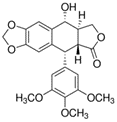INTRODUCTION
Podophyllotoxin is a non-alkaloid toxin lignan extracted from the roots and rhizomes of Podophyllum species. It is an organic heterotetracyclic compound that has a Furonaphthodioxole skeleton bearing a 3,4,5-trimethoxyphenyl substituent.
Manufacture
The two step manufacturing process involves extraction of crude Podophyllotoxin from harvested root of Podophyllum E.modi using suitable solvent followed by crystallization and oven drying.
| Synonym | 1,3,3a,4,9,9a-Hexahydro-9-hydroxy-6,7-(methylenedioxy)-4-(3′,4′,5′- trimethoxyphenyl)benz[f]isobenzofuran-3-one |
| Plant Source | Podophyllum E. Modi |
| Part of Plant | Root |
| CAS no. | 518-28-5 |
| EINECS no. | 208-250-4 |
| Molecular formula | C22H22O8 |
| Molecular weight | 414.41 |
| Structure |  |
Applications
| APIs |
|---|
| Podophyllotoxin is classified as ATC class: D06BB04 drug and is listed in WHO’s list of Essential Medicines |
| Antineoplastic and antiviral activities are the most pronounced pharmacological effects of Podophyllotoxin. It is a cytotoxic agent that binds to DNA and inhibits protein synthesis |
| Podophyllotoxin has also been shown to have anti-cancer effects in leukemia and other cancers, as well as being a potential anticancer drug for acute leukemia. It has been shown to induce oxidative stress and cell death in cancer cells |
| It is used for the topical treatment of genital warts in children and dermatological conditions caused by Psoriasis vulgaris as well as Molluscum contagisum infections |
| It may also be used as a therapeutic agent to treat genital tumors, Wilms tumors, lung cancer, and lymphomas |
SPECIFICATIONS
| Test | Unit | Specification |
|---|---|---|
| Appearance | Visual | White to off-white powder; no visible evidence of contamination |
| Identification by IR | – | To conform to structure |
| Melting point | °C | 175.0 – 185.0 |
| Assay by HPLC | % | Min 90.0 |
| Heavy Metals | ppm | Max 20.0 |
| % Volatiles by LOD (2 hours, 105°C under vacuum ) | % | Max 3.0 |
| Chromatographic Purity by HPLC | ||
| 4’-Demethylpodophyllotoxin | % | Max 8.0 |
| Specified impurity @ RRT 0.80 | % | Max 0.5 |
| Specified impurity @ RRT 1.34 | % | Max 1.0 |
| Specified impurity @ RRT 2.4 | % | Max 0.5 |
| Picropodophyllin | % | Max 0.5 |
| Individual unknown impurities | % | Max 0.5 |
STORAGE
Stored at 2 °C – 8°C
PACKING
15 kg UN approved cartons
REACH Status
Not registered
ExSyn offers Podophyllotoxin Crude on commercial scales under refrigerated transport and welcomes enquiries. No matter the quantity you need, our exceptional quality and service will make ExSyn your supplier of choice! If you need any additional information or SDS, please contact us.
Iodine is anon-metallic, dark-grey/purple-black, lustrous, solid element. It is the heaviest and the rarest of stable halogens that can be found on the crust of earth.About fifty percent of all iodine produced and manufactured worldwide is used to form Organoiodine compounds. Iodine is an important element for many health-sustaining processes and essential for human thyroid health.
The product, acronymed Oct-NBE, is an organic compound with a cyclic ring system and a 8-membered hydrophobic chain. The structure renders the chemical special properties leading to its applications in diverse fields.
Nicotine is a hygroscopic, colorless to slight yellow, oily liquid, that is readily soluble in alcohol, ether or light petroleum. It is widely used recreationally as a stimulant and anxiolytic.
The product, acronymed ETD, is an organic compound with a fused bicyclic ring system and an ethylidene group. The structure renders the chemical special properties leading to its applications in diverse fields.
Sodium perchlorate monohydrate is the inorganic compound with the chemical formula NaClO4•H2O. It is the common existence form of sodium perchlorate, which can gradually absorb water in the air to form the monohydrate. Sodium perchlorate monohydrate is white rhombic crystal which is highly soluble in water and in alcohol. Its capacity to undergo redox reactions, liberating oxygen atoms, has been harnessed in the preparation of specialty chemicals, including pharmaceutical intermediates and fine chemicals.
Triphenylphosphine is a common organophosphorus compound that is frequently abbreviated as PPh3 or Ph3P. It is widely used in organic and organometallic compound synthesis because it is an effective reducing agent as well as a neutral ligand. At room temperature, PPh3 crystals are relatively air-stable and colourless.
Potassium chlorate holds significant importance across various industries due to its diverse applications. This white crystalline compound has been utilized for centuries as an essential ingredient in the production of matches, fireworks, and explosives, owing to its ability to release oxygen upon decomposition.
Octadecylphosphonic acid (ODPA), a versatile chemical compound, serves as a surfactant and dispersant in applications spanning coatings, lubricants, and corrosion inhibition. With its hydrophobic octadecyl chain linked to a phosphonic acid group, it excels in surface modification, boosting adhesion in metal surfaces.
2-(Benzylmethylamino)-1-phenylpropanone is an organics intermediate from ketone category. It is a compound with notable pharmacological potential and itself has excellent cytotoxic properties. In trade, the chemicals is referred to as AMK.
